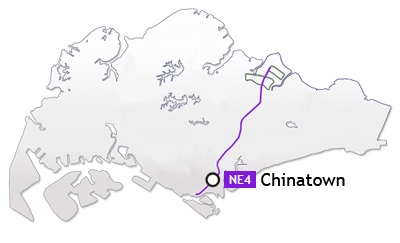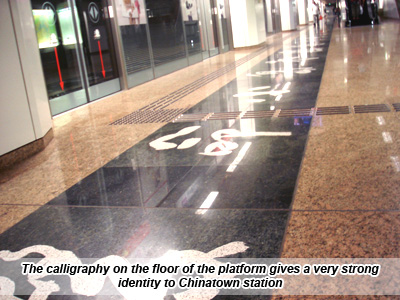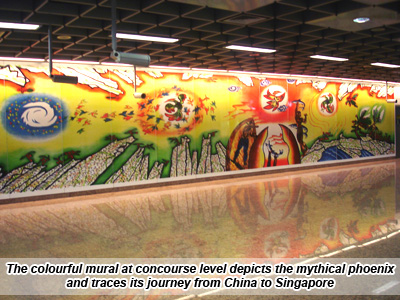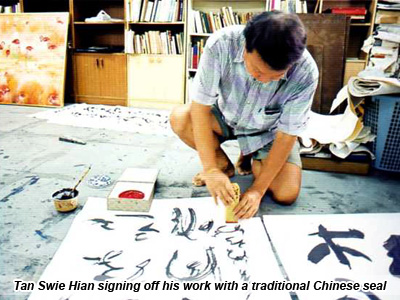|

Chinatown station

Located next to People's Park Complex in the heart of Chinatown, Chinatown station was
designed to reflect the oriental culture
and commercial vibrancy of the
area.
In designing Chinatown station, the architects had to take into account the density of the
built-up space around the station and the
need to preserve the character of
the heritage shophouses along Temple, Terengganu, Pagoda and Mosque Streets. One particular challenge was the design of
the Pagoda Street entrance. To
preserve the unique ambience of this narrow street, the architects built a pavilion-style transparent roof that rises above the
existing shophouses while allowing
natural light into the station.
The station runs under the busy intersection of Eu Tong Sen Street and New Bridge Road, and is wedged between two rows of
buildings. During construction, work
was confined to a narrow, compact space. The depth of Chinatown station is comparable to the six-storey Yue Hwa Building
close by. The building of Chinatown
station included the restoration of the Garden Bridge whose new features include a small stage, a foot reflexology path and
additional seating areas.
Back To Top
Tan Swie Hian was the Cultural Medallion Winner for 1987 and he is described by the
famous Chinese painter, Wu Guan Zhong,
as 'an outstanding son of the Yellow
Emperor'.
His works at Chinatown station, entitled "The Phoenix's-Eye Domain" are made up of a wall
mural telling the story of early
Chinese immigrants in Singapore and a
poem in three sets of rhyming couplets describing this journey.
The mural, a richly-coloured, resplendent work with a phoenix as its centrepiece, is located
at the concourse level. The poem,
which comprises of two seven-
character couplets and a forty-character couplet respectively, is presented as floor calligraphy at the concourse and platform levels. The poetry is a footnote to the
mural and the mural is an illustration of the poem.

Back To Top
Tan Swie Hian chose the phoenix as a transcendental symbol for the unflinching spirit of
the early settlers. The mural shows the
phoenix flying to Singapore, soaring
over the waterfront at Telok Ayer. Adorning the body of the phoenix are five Chinese characters standing for Virtue,
Righteousness, Civility, Benevolence and
Credibility. They are the five core values that uphold the spirit of man.
Another section of the mural shows the phoenix in full glory, surrounded by hundreds of
birds of various species. This, according
to the artist is an auspicious sign
denoting the prosperity of Singapore. The final section of the mural shows the phoenix and the birds merging in a spinning
spiral of universal energy; a commentary
on the never-ending cycle of life.

Back To Top
Tan Swie Hian's mural portrays the coolies not as downtrodden workers but as well-built
men in triumphant poses.
The artist worked on the murals for months and completely by hand. Eschewing the
airbrush, he achieved the luminous colour
gradation of his works by rubbing oil
and acrylic paints directly onto the canvas, without first diluting them with painting medium as is customary. This sophisticated
treatment of colour proved to be a
challenge to reproduce when his work subsequently went into production in the United Kingdom. After extensive trials, the
specialist company in Birmingham used a
seven-colour process to ensure that the final artwork in vitreous
enamel achieved as close a colour match as possible to the artist's originals.
Swie Hian's poem, written in semi-cursive calligraphy script, presented other challenges.
The literacy form employed by the artist
is the couplet, comprising a pair of
complementary verses aligned side by side. Adjacent characters in both the verses are perfectly matched in meaning and
metre. The work is a complex synthesis of
visual symmetry, linguistic precision and calligraphic excellence.
Back To Top
Swie Hian worked in ink on rice paper. The characters were later scanned into a computer
and reproduced on granite slabs of 1.2
metres square. Individual
characters in calligraphy were cut out using water jet from granite slabs in a lighter shade of grey. The cut-out characters
were then inlaid in granite slabs of a darker
tone with the same characters hollowed out.

The creation of Swie Hian's works is but the first step in a longer journey. More meaningful
to the artist will be the way commuters
respond to his works. It gives him
joy to think that his calligraphy is on the same earth on which his forefathers first set foot in Singapore, dreaming of a better
life.
Artist:
Tan Swie Hian
Born: Indonesia, 1943
Education:
- Bachelor of Arts (English Literature), 1968
Nanyang University, Singapore
next: Clarke Quay station
Back To Top
|